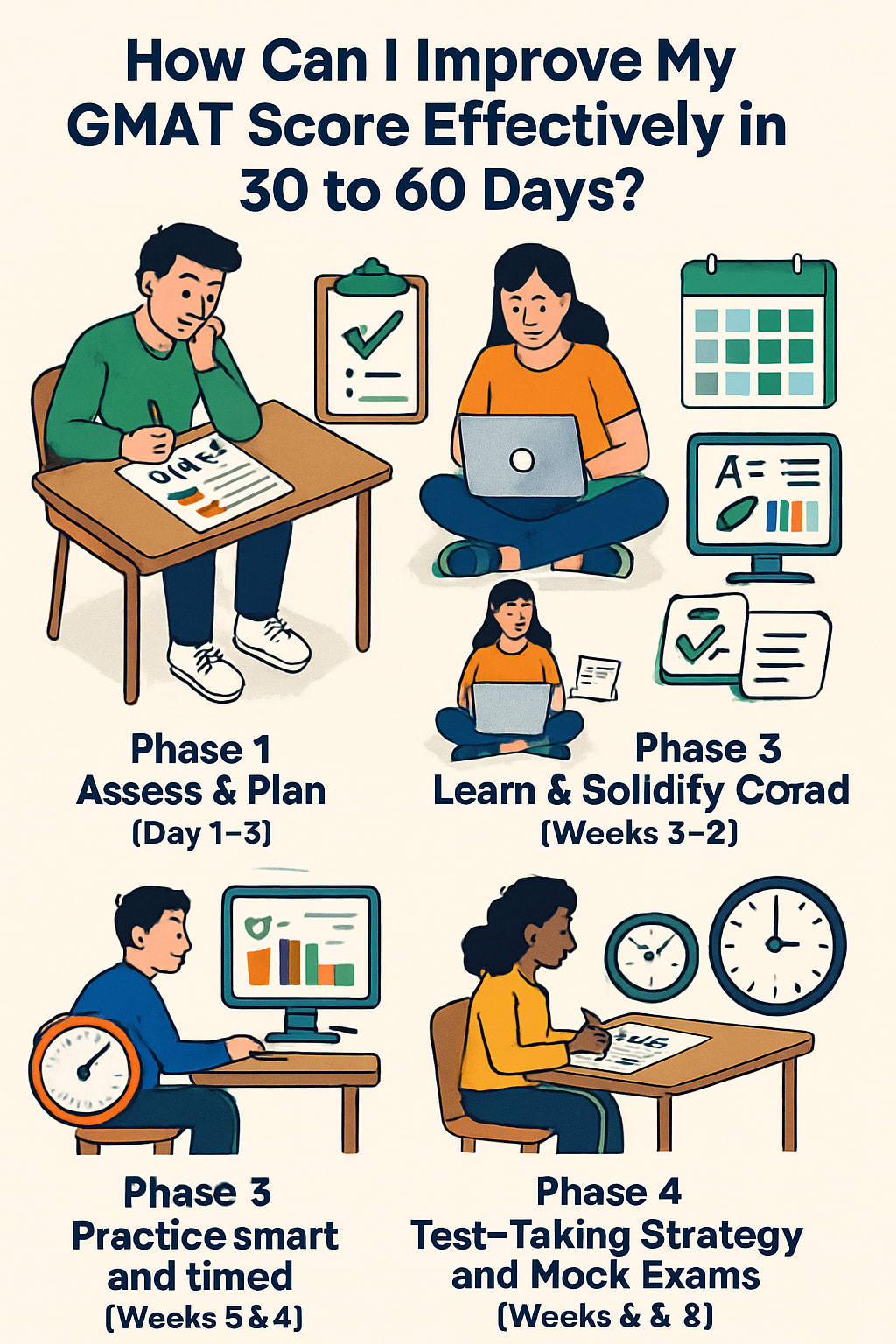GMAT Score Requirements for Admission to Top B-Schools in 2025
Table of Contents

Are you aware that more than 90% of leading MBA programs treat the GMAT score as one of the most important parts of the evaluation process? Furthermore, in a highly competitive admissions environment, the GMAT score could be the determining factor between acceptance and rejection—especially in 2025, when business schools will likely have an enormous influx of quality applicants.
According to GMAC (Graduate Management Admission Council), the current average GMAT total score for the top 20 global business schools ranges from 700 to 740. In other words, it is possible that even a good GMAT score in the upper 600 range may not be sufficient for an elite institution, such as Harvard, Stanford, or INSEAD.
What Is the Section-Wise GMAT Score Breakdown and How Is It Calculated?
Four GMAT score sections test your skills in mathematical and verbal reasoning, information analysis, and writing. The most important statistic MBA programs look at is your Total Score (200-800), but the sections each play an individual role.
The following shows the scoring of each of these sections and what that score implies about your application.
| Section | Score Range | Key Details |
|---|---|---|
| Analytical Writing Assessment (AWA) | 0 – 6 (in 0.5 increments) | Tests critical thinking and communication through essay writing. Scored separately. |
| Integrated Reasoning (IR) | 1–8 (in 1-point increments) | Measures data interpretation, multi-source reasoning, and problem-solving skills. |
| Quantitative Reasoning | 6 – 51 | Measures data interpretation, multi-source reasoning, and problem-solving skills |
| Verbal Reasoning | 6 – 51 | Tests reading comprehension, critical reasoning, and sentence correction |
| Total Score (Quant + Verbal) | 200–800 | Based on the Quantitative and Verbal sections only. Most test-takers score between 400 and 600. |
How Does the GMAT Score Chart Work and What Are the Percentile Rankings?
You are not the only person who is curious if a GMAT score of 700 is good enough for a school like Harvard or what a score of 640 means. If you have ever asked yourself these questions, you are in excellent company. Knowing how the GMAT score chart and percentile rankings work will help you to understand where you stand and whether you are competitive with your application.

The GMAT score report does not just reflect a score. The total score is a composite score derived from your performance on the Verbal portion and the Quantitative portion of the test, while AWA and IR are scored separately. Each score also has a percentile rank, which indicates how well you did compared to other test-takers around the world.
GMAT Score Breakdown: Total Score vs Percentile
| Total GMAT Score | Percentile Ranking | What It Means |
|---|---|---|
| 800 | 99% | Top 1% of all test-takers—near-perfect score |
| 750 | 98% | Strong score for Ivy League and top B-schools |
| 700 | 88% | Highly competitive; accepted by many top 50 MBA programs |
| 650 | 70% | Good score; sufficient for many reputed B-schools. |
| 600 | 53% | Average score globally may limit top-tier options. |
| 550 | 38% | Below average; may be accepted by non-competitive programs |
| 500 | 27% | Weak score; needs improvement for competitive programs |
| 450 | 17% | Very low score; major disadvantage for MBA admissions |
| 400 | 10% | Bottom 10%; most schools will require a higher score |
The Importance of Percentile Rankings
Although your GMAT score represents your raw performance, the percentile ranking indicates how you rank amongst your peers. For instance, if you received a GMAT 700 score and are in the 88th percentile, you scored better than 88% of test-takers worldwide. Most top MBAs prefer applicants that are in the 90th percentile or above, especially when providing competitive scholarship offers or recruiting for executive MBAs.
What GMAT Score Do You Need to Get Into Top MBA Programs?
There are several things that may be taken to be a good score in top business schools; a GMAT score of 700 or more on the GMAT is often regarded as a good score. Nevertheless, the good score depends on the school (its competitiveness). A few elite schools, such as Harvard, Stanford, and Wharton, can have average classes of about 720-740.
Business school GMAT Scores:
- Top MBA Schools: (Harvard, Stanford, Wharton, INSEAD, LBS): 730+
- Mid-Tier Business Schools (IE Business School, Kelley, Rotman, McGill, ISB): 650-700
- Lower-Tier MBA Programs: 580-650 (can still offer good career opportunities with the aid of good application aspects)
Things to put into consideration:
- School Rankings: Better schools mostly possess higher mean GMAT scores among selected applicants.
- Program Type: The expectation of higher scores, in most cases, applies to MBA programs as compared to specialized master’s programs.
- Applicant Pool: The score of “good” may be affected by the competitiveness of the body of applicants in that particular year.
- Overall Application: The GMAT score is only one of the parameters followed in the process of admission. In addition to a strong GMAT score, having good work experience, a solid academic background, and demonstrated leadership skills is also very important.
Quickly summarized, a 700+ score is a good target score, but it is always vital to research the concrete average scores of schools the applicant is interested in, as well as how the score translates to the rest of the applicant’s profile.
How Long Is a GMAT Score Valid and What’s the Policy for Retaking the Exam?
The validity of the GMAT is five years from the test date. People can retake the GMAT as many times as they want, but there are rules regarding how often they can retake it. There is at least a 16-day waiting period between sessions, and an exam can be taken no more than five times in a given 12-month rolling period or eight attempts overall.
The main facts concerning GMAT score validity:
The five-year validity: GMAT scores are said to be valid up to a period of five years after the test date.
No score extensions: Expired scores are not recoverable and unextendable.
Latest best: The business schools will most likely accept the latest valid score.
How Can I Improve My GMAT Score Effectively in 30 to 60 Days?
The short answer is that improving your GMAT score in 30–60 days is possible—if you have a focused strategy in mind. Here’s a slightly more realistic, smarter plan to get you there without burning yourself out.

1. Phase 1: Assess & Plan (Day 1–3)
✅ Take a full-length GMAT mock exam (official or reliable) to
Identify your baseline score
Identify your weak areas: Quant? Verbal? IR? AWA?
✅ Set your score goal
Set a clear, realistic goal that is slightly better than your baseline (ex. 550–650 or 650–700+)
✅ Create your personalized study plan
Use all the days in between your baseline and your planned GMAT exam as allocated study plan days. For example, if your exam is 50 days away and today is your baseline, then you have 50 study days before your exam! Aim for roughly 2–3 hours of study time on weekdays and 4–5 hours on weekends, for more total study time.
Spend more time on your weaker areas first—but also review your strengths!
2. Phase 2: Learn & Solidify Core Concepts (Week 1–2)
Quant Section
Review arithmetic, algebra, word problems, data sufficiency
Use the GMAT official guide and concept-based videos/notes
Practice 15–20 tactical questions daily
Verbal Section
Review sentence correction rules, reading comprehension techniques, and critical reasoning logic
Practice 3 RCs and 10–15 SC/CR daily
Learn patterns of grammar and common traps
Integrated Reasoning & AWA
Review basic types of IR questions (graphs, tables, multi-source reasoning)
Practice 2 AWA essays/week using official templates
3. Phase 3: Practice smart and timed (Weeks 3 & 4)
Time for the practice
Use GMAT question banks or apps with a timer
Create the real exam experience with pressure.
Review daily
Record your accuracy, timing, and the types of questions you’re missing.
You should keep a type of game log so that you can avoid repeating errors.
Be proficient in your data sufficiency and critical reasoning
These are very high yields for your scores.
Practice at least 10 each of DS and CR questions every day.
4. Phase 4: Test-Taking Strategy and Mock exams (Weeks 5 & 6)
Take 2-3 full-length mock tests
Ideally, at least 1 a week or every 5 days.
Make sure to review all of your errors deeply after each test.
Review your pacing strategy
Avoid getting bogged down on one question.
Learn to recognize when to guess and move forward.
Be determined to get better and better (but remember, GMAT is a separate test)
Above all, figurative accuracy is the first 10 questions in each section.
Think about mental stamina
This test will take more than 3 hours. So, work on the practice of just sitting through it.
Take breaks in between each section, just like the exam.
Is a 700+ GMAT Score Enough for Ivy League MBA Programs?
A 700 or higher GMAT score is typically seen as competitive by Ivy League MBA programs; however, with Ivy League MBA programs, it’s not a guarantee of admission. Ivy League business schools like Harvard, Wharton, and Columbia typically have GMAT scores averaging between 720-740. So while a 700+ GMAT score puts you in a favorable position, Ivy League admissions consider much more than just your GMAT score. They consider your work experience, academic history, leadership potential, and personal essays. In short, a 700+ GMAT score is a good starting point, but you need to have the rest of your application strong too.
Can You Retake the GMAT If You're Not Satisfied With Your Score?
Yes, you can retake the GMAT, as long as you’re unhappy with your score. To clarify, GMAC grants you the ability to take the GMAT no more than 5 times in 12 months and a total of 8 times in a lifetime (not more than once in 16 days). Many candidates improve their score with a second or third attempt by honing their approach and continuing to drill their weaker skills. Just be sure to prepare more thoroughly next time and use your previous performance to help you en route to suitable improvement.
Conclusion
Your GMAT score is not just a number: it is your ticket into top B-schools. Whether your target is a GMAT 700 score or you are simply wondering what a good GMAT score is, you should know the GMAT score range, percentiles, and school-specific GMAT requirements.
The GMAT total score is from 200, the GMAT minimum score, to 800, the GMAT max score. Most of the applicants are around the average GMAT score of 560 – 600. To differentiate yourself, particularly when you apply to competitive programs, I always say, ‘higher is better!’
Frequently Asked Questions
What Is the GMAT Score Range and How Is It Calculated?
The GMAT score range for the total score is 200 to 800, based on your performance in the Quantitative and Verbal sections. AWA and IR are scored separately and don’t count toward the total GMAT score.
What Is a Good GMAT Score for Top Business Schools?
A good GMAT score typically falls between 650 and 700+. For top MBA programs, a GMAT 700 score or above is highly competitive, though some elite schools have averages closer to 720–740.
What Are GMAT Percentiles and Why Do They Matter?
GMAT percentiles indicate how your score compares to other test takers. For example, a 700 score usually ranks in the 88th percentile, meaning you scored better than 88% of all GMAT candidates. Percentiles help schools assess how competitive your score is.
What Is the Average GMAT Score for MBA Applicants?
The average GMAT score globally is around 565–590, while top-tier B-schools report class averages between 680–730. It’s important to compare your score with the average for the programs you’re targeting.
What Is the Maximum GMAT Score You Can Get?
The GMAT max score is 800. Very few candidates reach this perfect score—less than 1% of all test-takers. A score above 750 is considered excellent and puts you in the top 2%






![Top-Career-Opportunities-After-PhD-in-India-[2025]](https://jaro-website.s3.ap-south-1.amazonaws.com/2025/10/Top-Career-Opportunities-After-PhD-in-India-2025-1024x576.webp)











